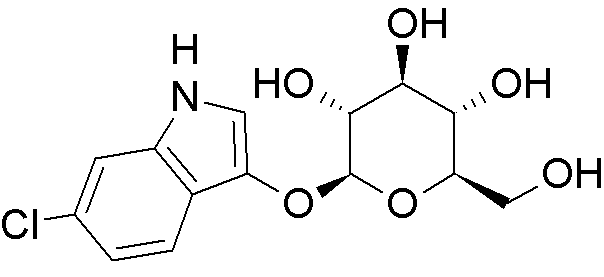6-Chloro-3-indolyl-b-D-galactopyranoside is widely utilized in research focused on:
- Biochemical Assays: This compound serves as a substrate in enzyme assays, particularly for β-galactosidase, allowing researchers to measure enzyme activity in various biological samples.
- Cellular Studies: It is used in cell culture experiments to study gene expression and cellular responses, helping scientists understand cellular mechanisms and pathways.
- Drug Development: The compound plays a role in the development of new pharmaceuticals, particularly in targeting specific enzymes, which can lead to more effective treatments with fewer side effects.
- Diagnostics: It is utilized in diagnostic tests to detect enzyme deficiencies or abnormalities in metabolic pathways, aiding in the early diagnosis of certain diseases.
- Research on Glycosylation: This chemical is valuable in studies examining glycosylation processes, which are critical for understanding protein function and interactions in various biological systems.
General Information
Properties
Safety and Regulations
Applications
6-Chloro-3-indolyl-b-D-galactopyranoside is widely utilized in research focused on:
- Biochemical Assays: This compound serves as a substrate in enzyme assays, particularly for β-galactosidase, allowing researchers to measure enzyme activity in various biological samples.
- Cellular Studies: It is used in cell culture experiments to study gene expression and cellular responses, helping scientists understand cellular mechanisms and pathways.
- Drug Development: The compound plays a role in the development of new pharmaceuticals, particularly in targeting specific enzymes, which can lead to more effective treatments with fewer side effects.
- Diagnostics: It is utilized in diagnostic tests to detect enzyme deficiencies or abnormalities in metabolic pathways, aiding in the early diagnosis of certain diseases.
- Research on Glycosylation: This chemical is valuable in studies examining glycosylation processes, which are critical for understanding protein function and interactions in various biological systems.
Documents
Safety Data Sheets (SDS)
The SDS provides comprehensive safety information on handling, storage, and disposal of the product.
Product Specification (PS)
The PS provides a comprehensive breakdown of the product’s properties, including chemical composition, physical state, purity, and storage requirements. It also details acceptable quality ranges and the product's intended applications.
Certificates of Analysis (COA)
Search for Certificates of Analysis (COA) by entering the products Lot Number. Lot and Batch Numbers can be found on a product’s label following the words ‘Lot’ or ‘Batch’.
*Catalog Number
*Lot Number
Certificates Of Origin (COO)
This COO confirms the country where the product was manufactured, and also details the materials and components used in it and whether it is derived from natural, synthetic, or other specific sources. This certificate may be required for customs, trade, and regulatory compliance.
*Catalog Number
*Lot Number
Safety Data Sheets (SDS)
The SDS provides comprehensive safety information on handling, storage, and disposal of the product.
DownloadProduct Specification (PS)
The PS provides a comprehensive breakdown of the product’s properties, including chemical composition, physical state, purity, and storage requirements. It also details acceptable quality ranges and the product's intended applications.
DownloadCertificates of Analysis (COA)
Search for Certificates of Analysis (COA) by entering the products Lot Number. Lot and Batch Numbers can be found on a product’s label following the words ‘Lot’ or ‘Batch’.
*Catalog Number
*Lot Number
Certificates Of Origin (COO)
This COO confirms the country where the product was manufactured, and also details the materials and components used in it and whether it is derived from natural, synthetic, or other specific sources. This certificate may be required for customs, trade, and regulatory compliance.


